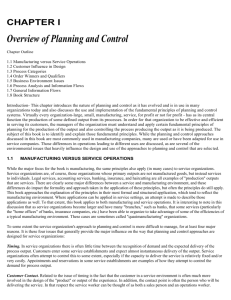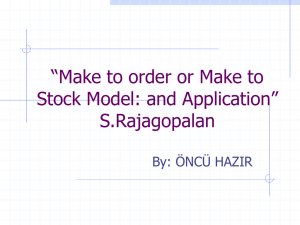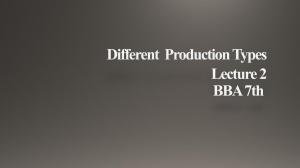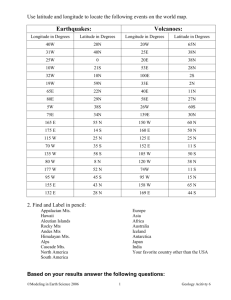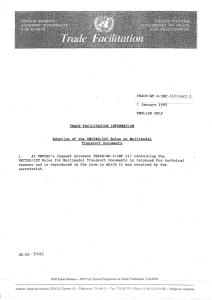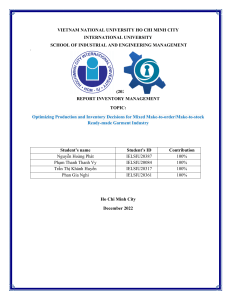Operations Strategy Continued
advertisement
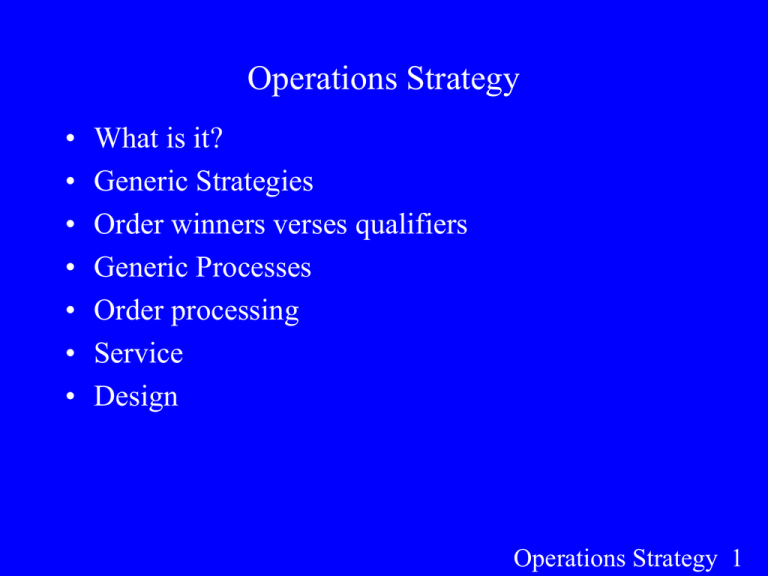
Operations Strategy • • • • • • • What is it? Generic Strategies Order winners verses qualifiers Generic Processes Order processing Service Design Operations Strategy 1 Linkages for Strategy • Key notion of strategy is that all functions must be pursuing functional strategies that support the business strategy. – Classic misalignment - usually driven by measures and rewards • marketing strategy based on differentiation and customization • operations strategy low cost • As a money person you need to understand how a company wins orders – an investment in quality might not increase profits but it might retain customers who would otherwise be lost (note marketing link as well) – Nissan article • As a money person you need to understand how work flows and the costs of changes • All managers should understand the tradeoffs inherent in some of the process choices they make (all managers manage processes) Operations Strategy 2 Strategy - how do we accomplish our mission? • If our mission is our company’s purpose, what is our strategy ? • For this class- strategy is Why a customer chooses us as opposed to another provider • Why do we need a strategy ? • What are generic strategies / priorities? – differentiation - better / unique • quality / flexibility (customization) – cost leadership- cheaper • price / cost – quick response- faster • delivery speed / delivery reliability / new product introductions Operations Strategy 3 Generic strategies: Differentiation- we do something unique / better • The customer defines better (keep this in mind when we discuss quality) • Examples: – – – – Rolls Royce - quality Sam Adams / Deschutes Brewing - quality Lightspeed - quality /flexibility / customization Dell – flexibility / customization Operations Strategy 4 Cost leadership - cheaper • Lower cost (usually but not always price) than main competitors • Examples – – – – South West (price) General Motors (price) Wal-Mart (price) Maytag – Neptune washers (cost) • Less H2O and power • Fewer repairs (increased availability) Operations Strategy 5 Quick response - faster • We can provide a product (or service) faster and or more reliably than the competition • Examples – – – – – – McDonalds (Fast) Fed-Ex (Fast&Reliable) Panasonic (Fast) Caterpillar (Fast&Reliable) Sony (Fast) Chrysler (Fast) • PT Cruiser verses GM’s retro car – due in 2006. Operations Strategy 6 Order winners and qualifiers: a way to view competitive priorities • Order qualifier: those attributes our product must have to compete – Airline • safety • access (to destinations) – Appliance • functionality • standard sizes and power requirements • Order winner: those attributes that differentiate our products: – Airline: • price (Southwest) • access (American) – Appliance • financing (Kenmore) • cost (Magic Chef) • durability (Maytag) Operations Strategy 7 A process is? • From an operations standpoint a process is a set of organized activities that are performed to add value for our customer – manufacturing processes • fabricate / assemble / machine / form – service processes – there are many other processes directly related to OM • order taking processes • order filling processes • inventory processes • From a broader perspective everything we do has a processes that can be understood, managed and improved upon Operations Strategy 8 More process • The choice of process for any activity will effect: – – – – – how fast it is how easy it is to change (flexibility) how expensive it is to buy and to operate the quality of the outputs the ability to customize outputs • This is true for any business activity – What are accounting processes ? Finance ? Marketing ? MIS ? Operations Strategy 9 How work flows through our processes influences our ability to be faster, better and or cheaper. • There are two basic ways for work to flow through processes for either a good or service 1) The Line Flow: all orders move through the same steps in the same sequence (line and continuous on product process matrix) 2) The Jumbled Flow: each order goes through different steps in potentially different orders (job shop and batch processing on product process matrix) Operations Strategy 10 Low Volume One of a Kind I. Job Shop II. Batch III. Assembly Line IV. Continuous Flow Few High Multiple Major Volume, Products, Products, High Low Higher StandardVolume Volume ization Flexibility (High) Unit Cost (High) Commercial Printer French Restaurant Heavy Equipment Coffee Shop Automobile Assembly Burger King Sugar Refinery Flexibility (Low) Unit Cost (Low) Operations Strategy 11 Key points of the product process matrix • There are direct links between how we wish to sell (marketing) and how we produce our products / services • As we become more efficient we tend to become less flexible • Line / continuous flows are faster (for standard products) than batch or job shops • Job shops and batch production allows much more customization – Pirelli verses other tire companies • Continuous production is very standardized and very low cost (per unit basis - very expensive to install) Operations Strategy 12 Other issues • How does our process effect quality? – Line flows are generally fast and inexpensive - does that mean they are low quality ? • Are line flows always faster than jumbled type flows? • What happens when we move off the diagonal – high volume job shop – low volume continuous production ? • Does this seem to apply for services ? Operations Strategy 13 Line flow verses jumbled flow Line Jumbled Output- product or service Strength Equipment Scheduling Level of WIP Special Concern Operations Strategy 14 Order processing • Make to order (MTO) verses make to stock (MTS). – MTO : we receive an order before we produce our good or service. • lead time = backlog + production + order processing time – MTS : customer orders are satisfied out of inventory. • lead time = order processing time Operations Strategy 15 MTO - make to order • Benefits • Drawbacks • Variations – ETO: engineer to order – ATO: assemble to order (BTO is usually a form of ATO as well) Operations Strategy 16 MTS - make to stock • Benefits • Drawbacks • Services: We can not inventory a pure service. How about impure services ? Operations Strategy 17 Group exercise • MTS / Line: Pizza by the slice – American dream – no special orders at lunch • MTO / Line: Dominos – only make a pie when you order it- make it how you want it • MTS / Jumbled: Pizza Hut Lunch Buffet – all sorts of vaguely Italian food sitting and waiting for youcan’t make pasta in a pizza oven • MTO / Jumbled: Pasta Petes (Italian restaurant and pizza place in Eugene) Operations Strategy 18 Group exercise questions • What are the order qualifiers for your industry? – Do these have any influence on process choice? • What are the order winners for each individual company? – Would you expect similar order winners for companies in other industries with similar processes? Operations Strategy 19 Interaction of work flows and order processing • Note how our strategy / order winners are related to the choices we make. – If customers demand lots of variety and you compete on costs what will you do? • ATO on a line is one possibility • MTS jumbled flow is another possibility • What is the difference between the two choices? – In the same market if you competed on higher levels of customization what would you do? • MTO and jumbled? • The key point here is that our processes should match our strategy ! Operations Strategy 20 Customer service and OM • Definition: giving the customer what they want, when they want it, every time they want it . • How can OM effect CS ? – process choice – process location – inventory – scheduling – capacity planning • Does service link to the strategy? • Does service = satisfaction ? Operations Strategy 21 Does service = satisfaction ? Quality Cost Satisfaction Design Service Operations Strategy 22 Elements of satisfaction • Cost and quality: two chief concerns of OM that we will discuss in detail. • Service: OM strategy decisions impact service. – Why does service stink article and banks • Design: Not a traditional OM responsibility. However, at many companies OM has a part in the design of products and process. Operations Strategy 23 Why is OM involved in design ? • In order to produce a design we must have the operational capability. Many companies wish to answer the question “can we make it” early in the design process. – Time to design a product – Cost of design and design changes • Design processes – Traditional – Harlan Co – Concurrent: DFM and DFE • DFX- design for X (something) Operations Strategy 24 Harlan co • Small KC company that makes equipment to move planes around airports (tractors?) – Very traditional design process – Engineers will specify an entirely new part when an existing one will do • Lots of excess parts- lower volumes increase prices and reduces quality. – Production does not see the design until it is “ready” for assembly – and then they often have to toss it back over the wall – Purchasing is in same position as production Operations Strategy 25 Advantages of concurrent design and DFX • Speed: no more tossing things over the wall. • Cost- problems surface earlier in the design process (also effects speed). • Quality - do not try and make things we are not capable of. • Example – Xerox DFE (environment) – All copiers are designed to be remanufactured • Have to be easy to disassemble and rebuild – Use more screws and other hard fasteners as opposed to clips • generally use standard sized parts even when new models introduced Operations Strategy 26 Generalizing from design processes • DFX / concurrent design are ways to link multiple functions – can you expand upon this to other types of processes that also involve other functions? – Another way of asking this question: If you are in charge of process that influences a number of other people (functions, members of the supply chain) does the idea of concurrency have value? • i.e. Development of marketing plans • Key point- you may never be involved in design processes- but you are likely to be working with a process that involves multiple entities and the notion of concurrency may matter a great deal. Operations Strategy 27 Specific choices and strategy • Work flow: line flows are generally cheaper. They are also faster for standard products, but slower (if this is even possible) for custom products. • Order processing: MTS has higher inventory costs but is faster. What type of products are MTS ? MTO ? What can we do to try and decrease leadtime in MTO ? Operations Strategy 28 More strategy choices • Design: By involving manufacturing in design we may be able to reduce costs and lead-time. WHY ? • Key point: Our company’s definition of customer service and satisfaction leads to specific operations strategy choices. As it leads to specific marketing / accounting/ etc. / choices. Operations Strategy 29 Strategy: conclusions • OM goals are to be faster, better and / or cheaper. • What is the purpose of operations strategy. – To determine the right mix of faster, better, and cheaper to satisfy our customers (to prioritize or if you will to make trade-offs). • process choice, work flow, order processing, inventory, capacity, etc.. Operations Strategy 30
